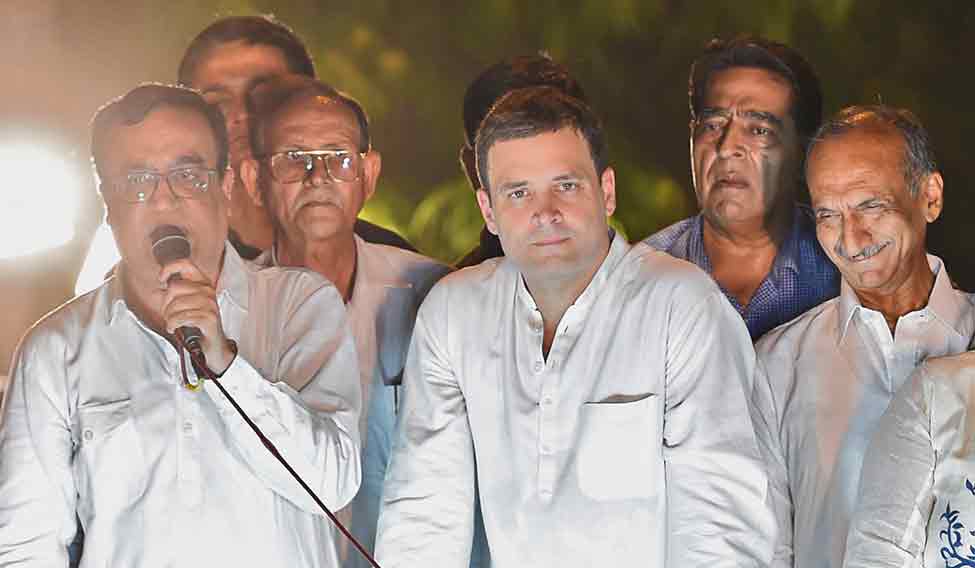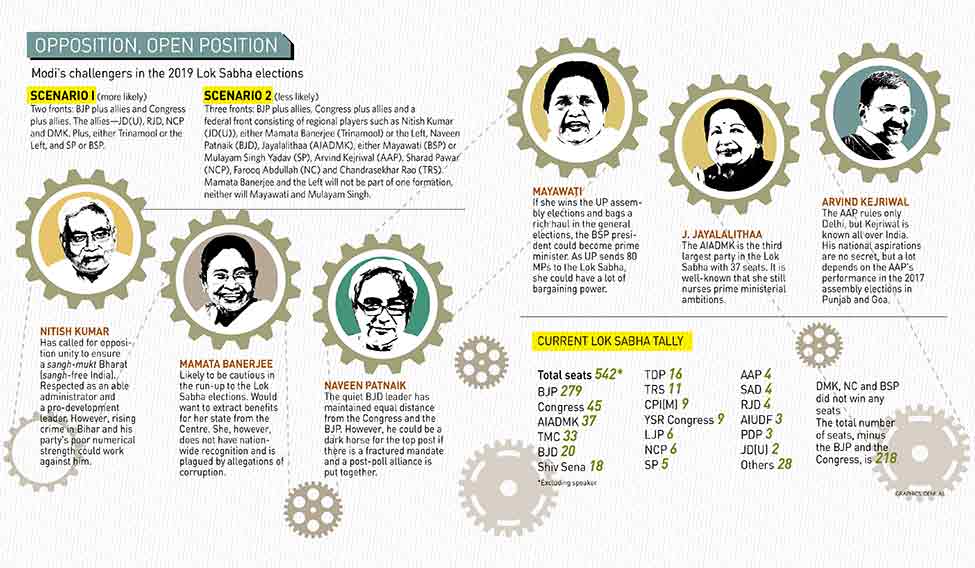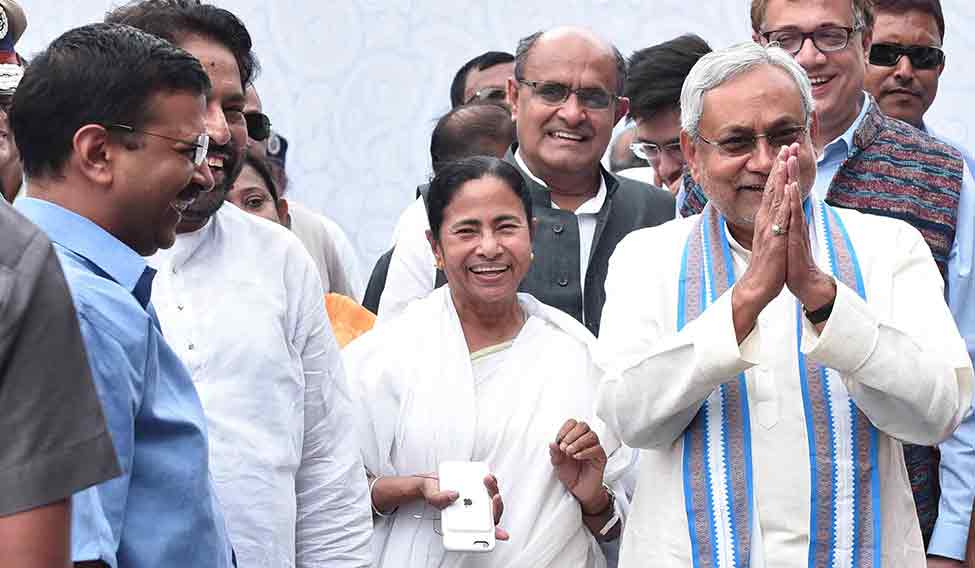The swearing-in ceremony of Mamata Banerjee on May 27 as chief minister of West Bengal for a second time, in her own words, was a “political get-together”. An elated Mamata was joined on the occasion by leaders of various political parties, and they included key regional players—from Nitish Kumar to Akhilesh Yadav to Arvind Kejriwal to Farooq Abdullah. The political significance of the occasion was not lost on anyone.
In this victory celebration of 2016 lay signs of what could be expected in 2019. The makings of a federal front to take on Narendra Modi in the Lok Sabha elections were visible. Nitish, with whom Mamata shares a great rapport, must be hoping to get her on board for the 'grand alliance' that he has proposed. He was among the first to congratulate Mamata, expressing hope that she and Kejriwal would join forces with him to protect federalism.
The occasion must have reminded Modi of the challenges that he would have to face in the form of regional satraps. If it was Nitish who had earlier staked claim to be his main challenger, now, Mamata, emboldened by her resounding victory, could be more vocal on issues of national importance, both inside and outside Parliament.
The secular space in Indian polity is abuzz with talks of a federal front. The moth-balled concept of a non-Congress, non-BJP front has been brought out and dusted. With the status of the Congress as the principal opposition force being threatened on account of its repeated electoral setbacks, its shrinking national presence and the absence of a viable revival plan, regional players are expected to vie for pole position as Modi’s principal challengers. They are likely to play a bigger role in national politics and could be the driving force behind such an alliance rather than the Congress putting it together.
It is not entirely impossible, according to political experts. “Modi’s principal opposition is coming from the regional parties as the Congress does not know what to do,” said Abhay Kumar Dubey of the Centre for the Study of Developing Societies, Delhi. He said that by the middle of 2018, the regional players would reveal their cards and it would become clear whether it would be a non-Congress front or one with the Congress playing some role.
 Tough task: Rahul Gandhi is perceived to be incapable of taking on Modi | Aayush Goel
Tough task: Rahul Gandhi is perceived to be incapable of taking on Modi | Aayush Goel
LAYING OUT A simple argument for a grand alliance, Pavan Varma, Janata Dal (United) leader, said the fact that the Modi government came to power with the lowest electoral support of 31 per cent of votes meant that close to two-thirds of the country voted for the opposition.
There is talk of a grand alliance, which is not driven by the Left. In the past it was the Left that made efforts to form a third front. This time around, Nitish has been first off the blocks to give a call for a 'grand alliance' that is bound by the common thread of opposition to the RSS and the BJP.
However, putting together such an alliance is not easy, which Nitish realised soon enough. His call was construed as an expression of his prime ministerial ambitions and he was snubbed by the Congress and other parties. This showed that the leadership issue would be the biggest hurdle in forming a front of the regional parties, with most of the leaders nursing prime ministerial ambitions.
Nitish’s national ambitions are clear. He has emerged as one of Modi’s prime challengers. The JD(U) said Nitish was “prime minister material”. He addressed a rally in Varanasi and has made efforts to expand his party’s footprint to Uttar Pradesh. He is, however, handicapped by the regional limitations of his party. “Nitish Kumar is as an experienced chief minister, who has provided Bihar with good governance and social uplift. There is no better match to Modi than Nitish. However, we are not an all-India party,” said JD(U) leader K.C. Tyagi.
Nitish's presence at Mamata’s swearing-in was also seen as his expectation of getting the Trinamool Congress supremo on board for his grand alliance. However, Mamata, after her resounding win in West Bengal, might not be willing to accept the supremacy of Nitish. Similarly, it would be difficult for Tamil Nadu Chief Minister J. Jayalalithaa or Odisha Chief Minister Naveen Patnaik, tall regional leaders in their own right, to accept the leadership of another regional player. Meanwhile, Kejriwal has already made it clear that he will have no truck with regional parties.
Jayalalithaa’s ambitions are no secret. The slogans on the posters and hoardings in Chennai once read, “From Fort St George to Red Fort”. Although such slogans were absent during the recent assembly elections, AIADMK sources said Jayalalithaa would weigh her options over the next one year before making her intentions clear.
POINTING TO THE challenges in putting together a federal front, Bhartruhari Mahtab of the Biju Janata Dal said a lot of work needed to be done. “The first is to find a common agenda of the regional parties, which will be a national agenda they can agree upon and work on,” he said.
Manoj Jha of the Rashtriya Janata Dal, however, is more optimistic. “When it comes to fighting for the existence of the Constitution, you have to fight together and not against each other,” he said. “Laluji [RJD leader Lalu Prasad] said we should realise that fighting in an isolated manner would not be easy.”
Meanwhile, it will be difficult to visualise Mamata together with the Left, or Samajwadi Party leader Mulayam Singh Yadav with BSP leader Mayawati or Jayalalithaa with M. Karunanidhi. Soon after the results of the recent assembly elections came out, Congress president Sonia Gandhi extended the olive branch to Mamata. Although the possibility of the Trinamool joining a Congress-led front remains, the Congress will have to sever its ties with the Left for that to happen.

“I HOPE THAT Mamata, Mulayam, Lalu, Jaya and [Akali Dal leader Parkash Singh] Badal will come together to form a federal front. We will not be competition in each other’s territories. And the leader can be chosen by consensus,” said Tyagi.
For the moment, however, Mamata is not expected to antagonise Modi. She is likely to keep her cards close to the chest till a few months before the Lok Sabha elections. She has declared that she will play the role of a “constructive opposition” even as she gave a thumbs up to the GST. It would make sense for her to extract benefits for her state from Modi and further buttress her position. She will also be circumspect because of the probes into corruption allegations against her party members. “There is nothing new in the policy, as we have maintained for long that we would play a responsible role in Parliament. We will oppose them where necessary and will support them where it is needed,” said Derek O’ Brien of the Trinamool. In an interview published on the Trinamool website, Mamata said her party would play an important role in national politics in the future. “The people are with us,” she said.
The regional parties are aware of the BJP’s plans to extend its presence in their strongholds. It could emerge as a threat to their brand of politics. The BJP has already launched an aggressive campaign in Uttar Pradesh, with party president Amit Shah naming the Samajwadi Party as its main opponent. A wary SP has directed its cadres to go on the offensive to counter the BJP threat. It is also looking at stitching up the right kind of alliances, for example with Ajit Singh’s Rashtriya Lok Dal, to contain the BJP in western UP.
While Modi talks of cooperation with Mamata at the Centre, his party is dreaming of unseating her in West Bengal. “We will be a major force in the coming days in West Bengal and would be the right alternative to the Trinamool,” said West Bengal BJP leader Rahul Sinha. Shrikant Sharma, national secretary of the BJP, said there could be a cooperative arrangement with the party at the Centre, but at the state level, the Trinamool was the BJP’s opposition. “Mamata is our political opponent in West Bengal and Jayalalithaa is our opponent in Tamil Nadu,” he said. As of now, AIADMK is the strongest regional party with 37 members in the Lok Sabha and 13 in the Rajya Sabha. “We are strong in the Rajya Sabha, too. We will ensure that Amma’s name is etched in history,” said Navaneetha Krishnan, MP.
The growing clout of the regional parties could prove to be a major challenge for the Congress. With Congress vice president Rahul Gandhi—set to assume charge as party president soon—perceived to be incapable of posing a strong challenge to Modi, regional leaders are likely to vie for the role of the main opposition. If Nitish has taken on Modi unabashedly and Mamata has declared that she is ideologically opposed to the BJP, Kejriwal, the third element of the federal triad, has been relentless in his attacks on Modi, be it on the issue of corruption, interference in the working of the Delhi government or the controversy over the veracity of the prime minister's academic credentials.
“It is not the Congress or Rahul, but the Aam Aadmi Party which is taking on Modi. So the AAP is the principal opposition party and Kejriwal is the principal opponent of Modi,” said party leader Ashutosh. Kejriwal will also be a challenge for Modi in Punjab and Goa, which go to the polls next year. “The AAP has emerged as a powerful brand in Punjab and Goa. We are providing people with an alternative to the Congress and the BJP in these states,” he said.
The role of the Congress in an anti-Modi front is still uncertain. It is unclear if it can bargain from a position of strength in the formation of an anti-Modi alliance. It is also doubtful whether tall regional leaders like Nitish or Mamata or Mulayam or Mayawati would want to accept Rahul's leadership. Union Finance Minister Arun Jaitley poked fun at the Congress, writing on Facebook: “Will it be the main challenger to the BJP-led NDA in 2019 or will it stand behind a hotchpotch combination of ideologically disparate regional groups?” The AAP's contention is that the Congress cannot be the alternative as it has lost to the BJP in all elections where the two parties contested directly against each other after the Lok Sabha polls in 2014.
Dubey said an alliance on the lines of the National Front of the 90s was possible, but he could not foresee the role of the Congress in this kind of an alliance. “To be able to bargain from a position of strength, the Congress will have to win one or two states. If the Congress is not able to bolster its position, a coalition of a third kind could take shape,” he said.
The situation today, he said, is similar to the 1970s, when the Congress was at loggerheads with everyone. “Today, the BJP seems to be at loggerheads with every regional force, and this could lead to a situation where they unite, and this could be without the Congress,” he said.
HOWEVER, others feel that the Congress will have to play a major role in the creation of any such alliance to bind together disparate regional forces. “Even today, the Congress is present in every village of the country. Nobody had thought that it would win the elections in 2004. Just because the Congress has lost in Assam and Kerala, we cannot say it is finished,” said Mahtab.
Congress leaders naturally agree. “If there is any political force that can challenge Modi in 2019, it is the Congress. Alignments will take place at the state level, but nationally, the Congress is the only relevant force,” said Congress leader Sachin Pilot. He said even now, it was his party that was taking on Modi at the national level, raising issues such as amendments to land acquisition, intolerance and corruption. “Kejriwal has been taking on Modi, but he is, at the end of the day, only the chief minister of Delhi. He does not have traction all over the country,” said Pilot.
 Loss of attraction: Uttar Pradesh (pointing finger) Chief Minister Akhilesh Yadav is unlikely to be part of an alliance including BSP supremo Mayawati | PTI
Loss of attraction: Uttar Pradesh (pointing finger) Chief Minister Akhilesh Yadav is unlikely to be part of an alliance including BSP supremo Mayawati | PTI
According to the Congress, the fight in 2019 will be between the BJP and its allies and the Congress and its allies. “Any secular alliance in this country has to have the Congress as its nucleus. The regional parties will have to ally with the Congress, for the simple reason that they do not have presence in states such as Rajasthan, Gujarat, Maharashtra and Madhya Pradesh,” said Congress general secretary Shakeel Ahmed.
However, the Congress needs allies, perhaps more than the regional parties need the Congress. But the Congress is unlikely to join an alliance where it is not seen as the leader. “We will go for alliances in 2019. However, those have to be formed state-wise. For example, we had an alliance with Nitish and Lalu in Bihar. Similarly, we will have alliances with like-minded parties in other states,” said Ahmed.
The role of the Left in cobbling together a secular alliance appears to be very limited. It was actively involved in the creation of the third front in the past, but those were the days when the Congress was in power and the search was for a non-BJP, non-Congress alternative. That role has been taken over by others. And the electoral debacle in West Bengal does not bode well for an understanding between the Congress and the Left in 2019. Anyways, the Congress will have to choose between Mamata and the Left.
Meanwhile, there is another opposition brewing against Modi, said Tyagi, adding it was not in the corridors of power. “Modi has not fulfilled his election promises, be it to bring back black money or increase minimum support price to farmers or create jobs. There is a lot of discontent. So, the opposition to Modi is not only from the opposition parties, but also from the people,” he said.
The question of who is really the opposition to a strong leader at the Centre has been asked earlier. In 1987, George Fernandes had said that there was no real opposition to Rajiv Gandhi. Had V.P. Singh not revolted against Rajiv, they would have had to invent a V.P. Singh. Modi, however, is not without opposition. It will make its presence felt in many ways before 2019 and may unite to take him on in the Lok Sabha elections.
WITH RABI BANERJEE, AJAY UPRETY, ANOOP M.S. AND LAKSHMI SUBRAMANIAN







